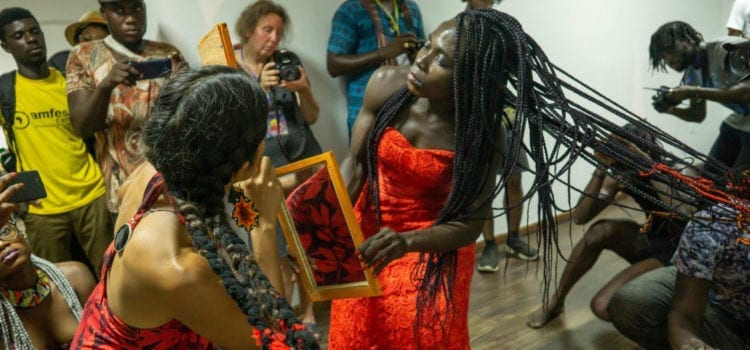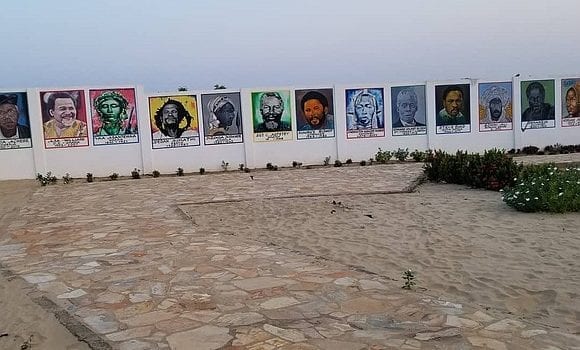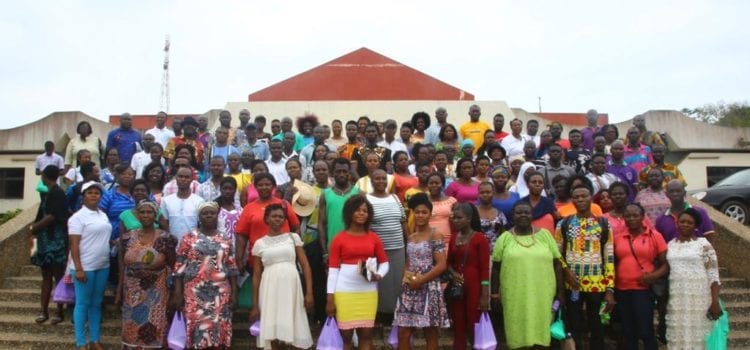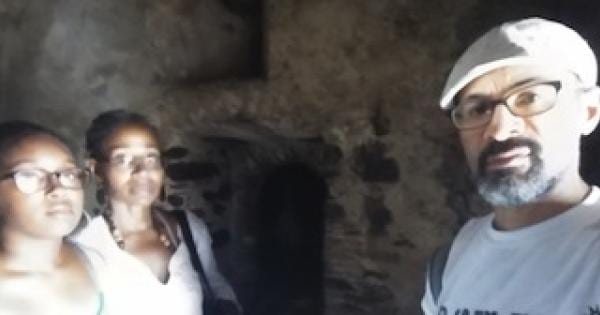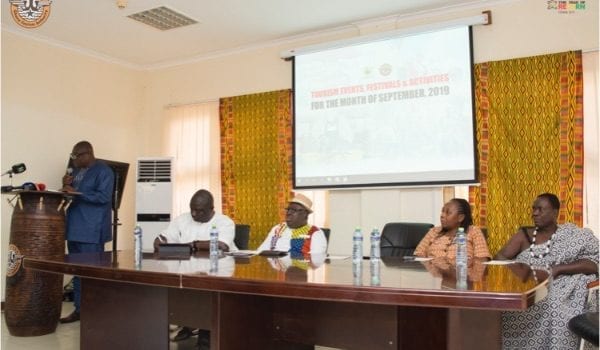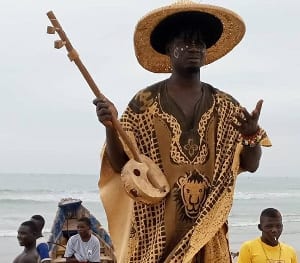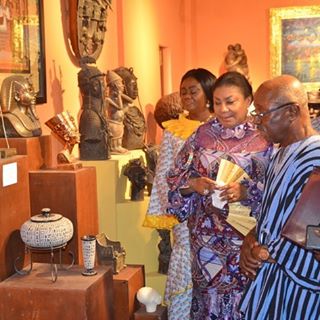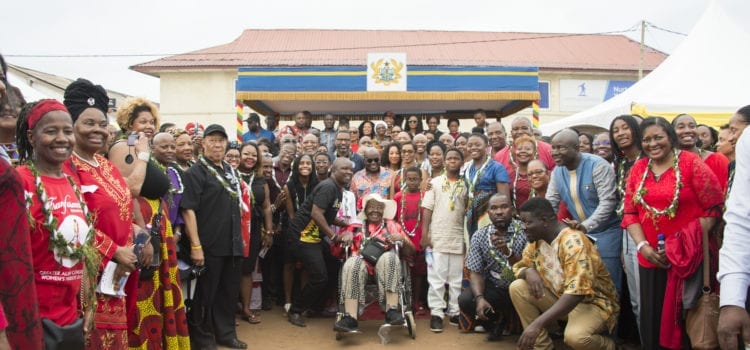Chale Wote: From local festival to boundary-pushing global platform
Accra’s Chale Wote Art Festival is West Africa’s largest annual street art and performance art festival. For the past 8 years, it has grown from a small local event to a global platform attracting an audience of about 50,000 people.
Founded in 2011, the festival began as a one-day event in the streets of Jamestown, the city’s oldest district. It was founded by artists who wanted to give new meaning to some colonial-era buildings that define the area — particularly, the 17th century British James Fort and the Dutch Ussher Fort.
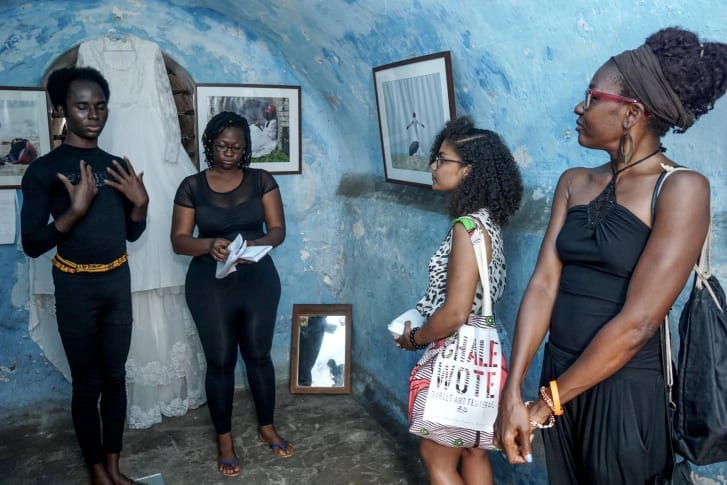
This year marks the fair’s largest edition to date, with over 160 Ghana-based and international artists exhibiting their work across 10 sites, during an 11-day program.
A platform for change
Performance art has always played an important role in the festival, and this year more than ever before, with a dedicated week-long programme.
For this edition, performances at Chale Wote were curated in collaboration with Ghanaian artist Va-Bene Elikem K. Fiatsi, also knows as crazinisTartisT, a self-described gender-nonconforming multidisciplinary artist and director of the perforcraZe International Artists Residency (piAR) in Kumasi.
“It is really hard, especially in Ghana, for unconventional art practitioners like my kind to display some provocative works in public or use certain spaces for their works,” explained Fiatsi in an interview at Chale Wote. According to Fiatsi, being included in an art festival setting creates an opportunity: “It gives the freedom to express, explore, exploit and discover their own limitations and possibilities.”
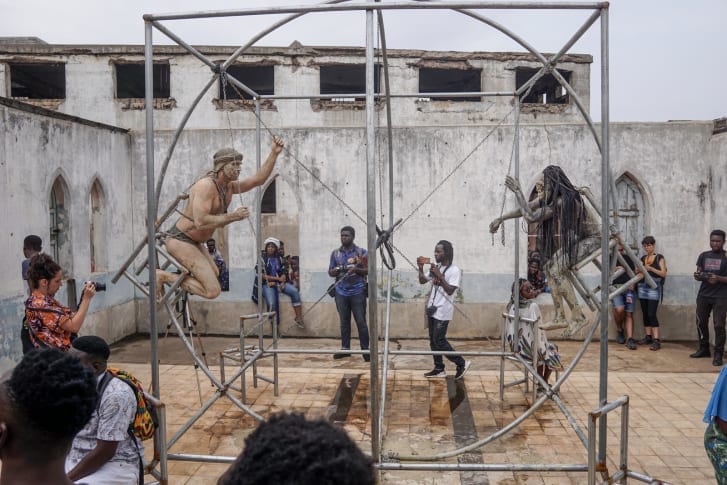
Fiatsi’s collaboration with John Herman, titled “Table of Negotiation” was one of the most popular performances this year and, at four hours’ running time, also the longest performance in the festival lineup.
In the piece, both artists were bound in chains and suspended above the audience in a monumental replication of Leonardo da Vinci’s famous Vitruvian Man drawing. Exploring notions of masculinity — Herman’s body is labeled as disabled due to an amputated leg, and Fiatsi is gender non-conforming — they pushed their bodies to their limits in a tug-of-war of sorts.
Individual forms of activism and artistic demonstrations for social change are not unusual during the festival. As Fafa MacAuley, Digital Publicity Coordinator for Chale Wote Art Festival explained in an interview at the festival, “Chale Wote was founded in 2011 by Accra[dot]Alt’s as an experimental platform for bringing art, music, dance and performance out of the galleries and into the local Ghanian community.” She continued: “It has always been a space for artists to freely express ideas that challenge the status quo, as well as offer a variety of art forms to push boundaries and connect to a wide-ranging audience.”
Other themes, such as violence against women, pain and marginalized bodies were also explored in performances that were both deeply moving and hard to watch.
In an entranced state punctuated by wails and screams, Cameroonian artist Kayifa began her performance “The memories of the body” outside of Ussher Fort on Cleland Road.
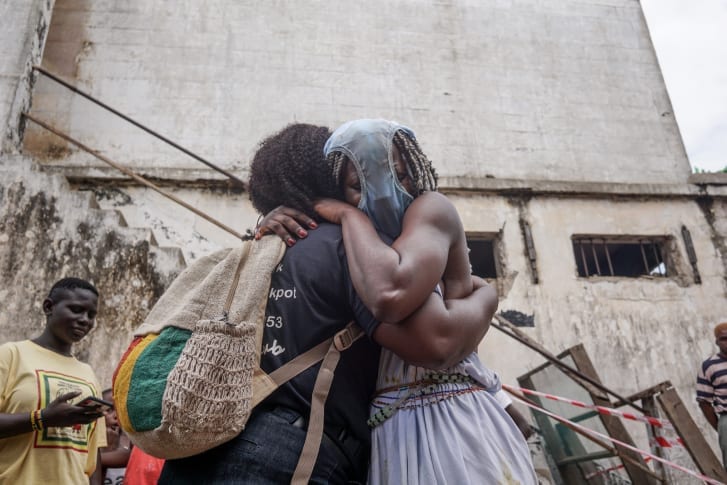
Kayifa’s work is autobiographical. During her piece, the audience followed her into a purpose-built healing circle for a two-hour long performance exploring domestic violence, rape and other forms of oppression directed toward female bodies. It culminated in a deeply moving scene, with the artist, exhausted and wearing her underwear on her face, inviting audience members into an embrace.
“My performances deal with domestic violence, rape, child trafficking, and other forms of female oppression,” said Kayifa. “Chale Wote provides an audience across ages and social class, and its important to use this as a platform for my fight and others.”
Growth of a festival
Once a small artist-led festival with experimental beginnings, Chale Wote is now an established tourist attraction. The festival relies on volunteers and offers no funding to participating artists, but it now attracts thousands of visitors each year. At the same time, the nature of the performances on display has also firmed up its position as a transgressive platform.
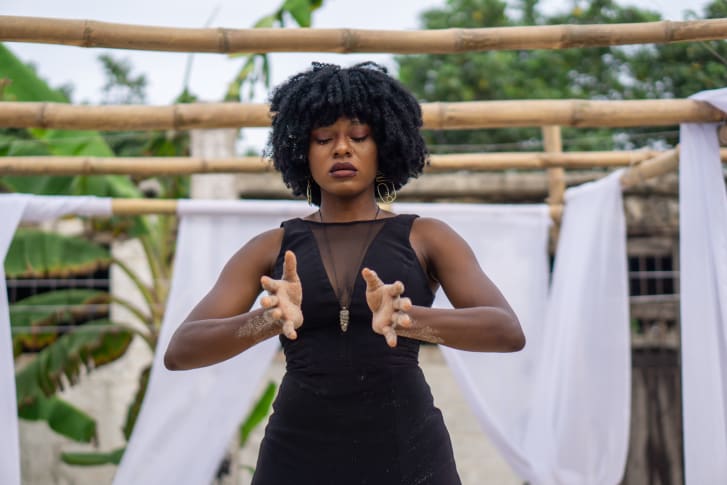
Fiatsi defines Chale Wote as “One of the most important spaces and platforms that merge art, locals, natives and internationals.”
Since its inception, Chale Wote has conquered much attention outside of its country of origin, which makes this year’s theme, “Pidgin Imaginarium,” as relevant as ever. It was described in the festival’s brochure as a response to “A continent on the precipice of a major shift, that will completely reset how Africans engage the rest of the world.”
Source: CNN
Ghana Tourism Authority embarks on review of beaches
The Ghana Tourism Authority (GTA) on Friday inspected the Titanic Beach in Sakumono and the La Pleasure Beach Resort all in the Greater Accra Region to evaluate the progress of their sanitation work and existing layout facilities.
The exercise was also to check on the security measures put in place by management of the beaches to secure the lives and health of users and check permits of individual structures built on the beaches.
The team was led by Mr Akwasi Agyemang, the GTA Chief Executive Officer and his two deputies as well as some staff members.
Mr Akwasi Agyemang said the Sakumono beach was one of the developing beaches used by many people in the Tema West Municipality and beyond, hence the need to ensure that it was clean and safe for people to use.
Mr Agyemang in the company of his team and Mr Kwasi Poku, the Presiding member Tema West Municipal Assembly, Mr Mujeeb Kutia, Works Sub Committee Chairman and Mr Vincent Blah Quarshie, Municipal Works Engineer, also said there had been lot of progress with the sanitation and layout since the team last visited in August 2018.
The Authority would engage the necessary stakeholders to come out with a master plan to give demarcations and situate some structures properly, he said.
At the La Pleasure Beach, the CEO gave a 10-day ultimatum to the management to meet certain requirements that were unavailable such as Fire Service Certificate, Environmental Protection Agency permit and Police clearance.
He said the failure to meet these requirements within the stipulated time would leave the authority with no option than to close down the facility.
Mr Agyemang said the time could be extended if the management of the La Pleasure Beach makes progress with providing documents that have been demanded.
He said the Authority is unhappy to take such measures as many people work within the facility and depended on that for their livelihood adding that the right thing should be done to create a serene environment for all.
Mr Vincent Blag Quarshie, Works Engineer Tema West Municipal Assembly, applauded the GTA for the exercise and assured them of much better and demarcated structures with the proper layout on their next routine check. He said some illegal structures along the access way would be demolished to allow free exit.
Source: GNA
Jerry Johnson’s Ancestral Wall: ‘Recognizing those who recognized us’
Jerry Johnson is from California. He lives in Ghana. He works in New Ningo. He founded the Ancestral Wall.
It is magnificent. There are 90 portraits of 90 heroes and sheroes and icons. Several artists used their skills to paint an outside gallery for students, visitors and locals alike. From Mariam Makeba to Steve Biko. From Na Gbewa to Imhotep.
“We are recognizing those who recognized us,” teacher and cultural entrepreneur Johnson told this reporter while walking through the altogether serene and informative grounds.
The pretty garden encompasses the impressive portraits and a really great restaurant, and terrific guest houses.
Fifteen years ago, this realized dream started as a desire to “begin teaching the local youngsters African history. But there are so many villages, so many schools I couldn’t do it logistically, so I got the idea that if I put 90 characters up on the wall, then I could bring the schools for field trips.”
Word-of-mouth spread, and now, worldwide, “It has become something of an attraction. I go from 200,000 years ago with Eve.”
There she is short-Afro’d and all. So many others too: from Eve to Francis Cress-Welsing. From King Tackie Tawiah I to Thomas Sankara. From Shaka Zulu to Dr. Yosef Ben-Jochannan.
“I picked them on themes that I wanted to teach the children, so you will see people who aren’t very famous at all, but there is a lesson or something they stood for that I wanted the children to hear in terms of our history, our ancestry, and the foundation of our African being.”
In this the ‘Year of Return’, and Ghana’s fully embracing the 400 year anniversary since so many Africans were snatched from the Coast of Guinea and brought to America and the Caribbean, Johnson is an epitome of a man returning to the source. From visitor to resident, bringing a skill set and an enthusiasm. Johnson is fully entrenched in Ghanaian culture.
“I was one of those who came from the U.S. with all of my books and my videos and thinking that I could spread some of the things we’d learned over the years in our study group meetings, and serious African study movement, with people like Cheikh Anta Diop and Asa Hilliard, John Henrik Clarke who influenced a lot of us. You really have to start with the youth because there’s really a lot of bad socialization that has gone on with the youth both here and in the U.S. in the minds of African people. It is easier to implant it in the beginning.”
Jerry Johnson’s passion, his raison d’etre is instituting an under established African history as common, everyday knowledge.
He told the Amsterdam News, “We do walkthroughs, and more and more people from the U.S. are coming through.”
The location is very, very calming. “This should be a place you come when you first come here to Ghana. It is a nice transition when you first come.”
Johnson’s parting words are an axiom to live by indeed; “The objective is to create the Africans we need to solve the problems that we have,” he said. “We are Garveyites, so we know we have to build something powerful in the world.”
Source: Amsterdam News
Ghana Tourism Authority trains informal sector operators in Western and Central Region
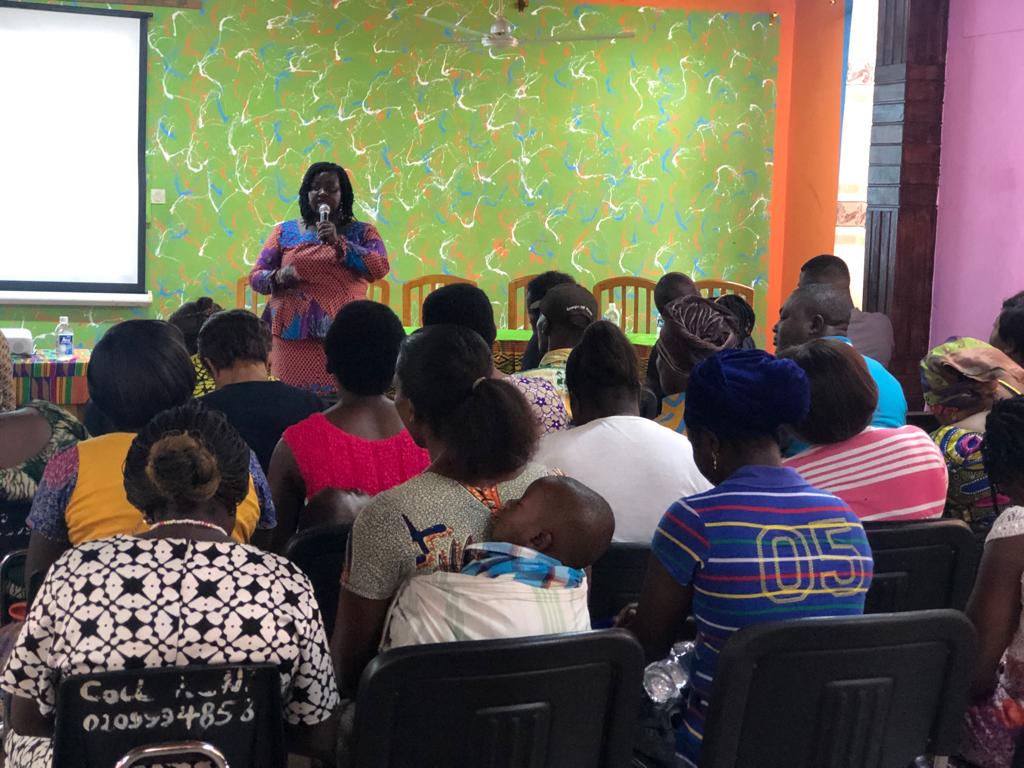
The Ghana Tourism Authority under the auspices of the Ministry of Tourism, Arts and Culture (MOTAC) has organised a training and sensitization programme for the Informal Food and Beverage sector of the Tourism Industry. This was done in partnership with the various Trade Associations under the Ghana Tourism Federation (GHATOF) which is the umbrella body of the Trade Associations / Private Sector wing. According to the CEO of the Ghana Tourism Authority, Mr. Akwasi Agyeman, the training programme falls in line with the Authority’s mandate of regulating the industry to ensure quality service delivery.
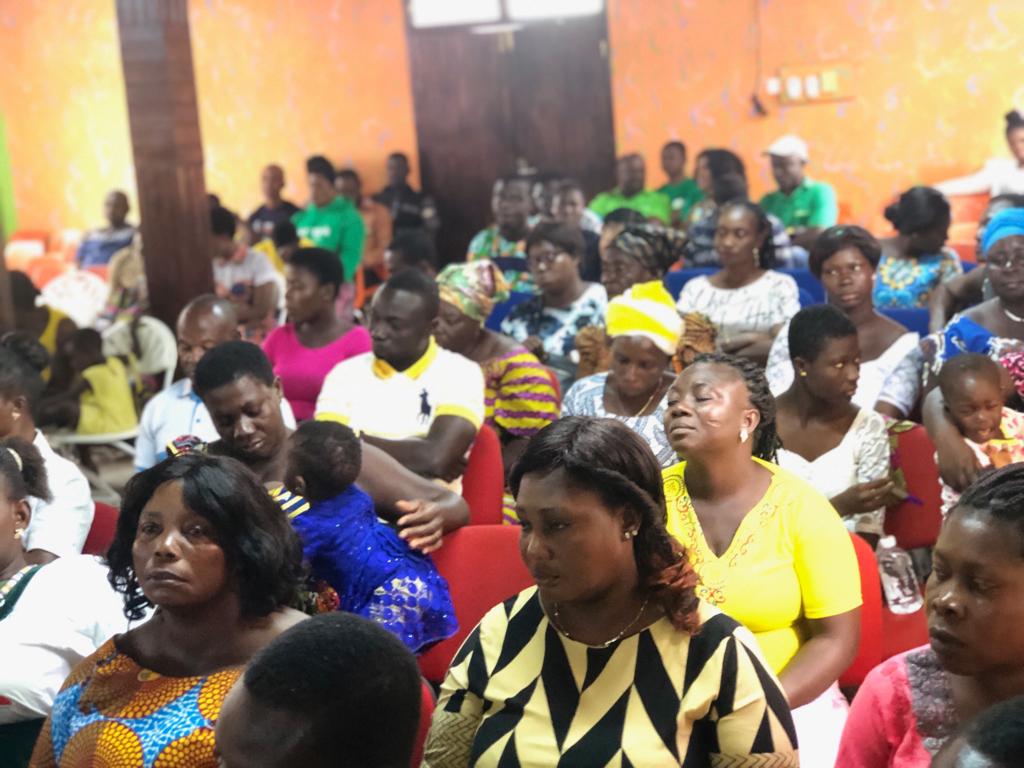
The training seeks to enhance the skills of informal food and beverage enterprise operators. This is in line with efforts to provide quality service to visitors from the diaspora as they come home for the “Year of Return, Ghana 2019”.
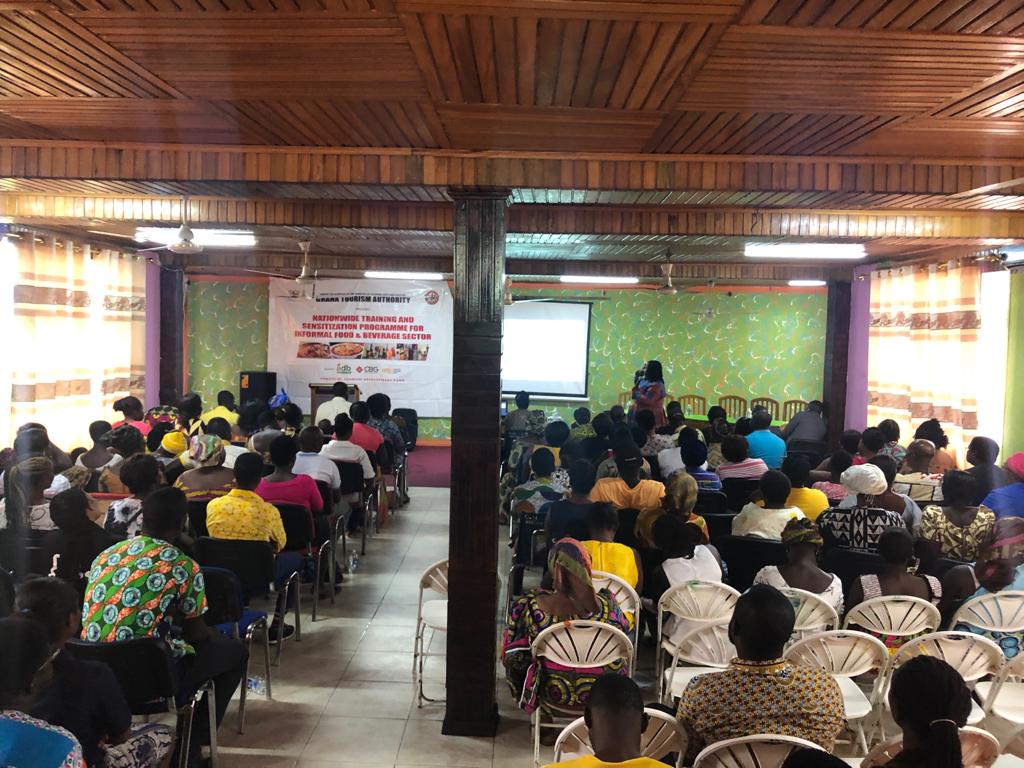
The Training Programme as funded by the Tourism Development Fund (TDF) was supported by the Agricultural Development Bank (ADB), the Consolidated Bank of Ghana (CBG) and the Universal Merchant Bank (UMB). These banks collect the 1% Tourism levy from Tourism Operators nationwide for deposit into the Tourism Development Fund on behalf of the Ghana Tourism Authority.
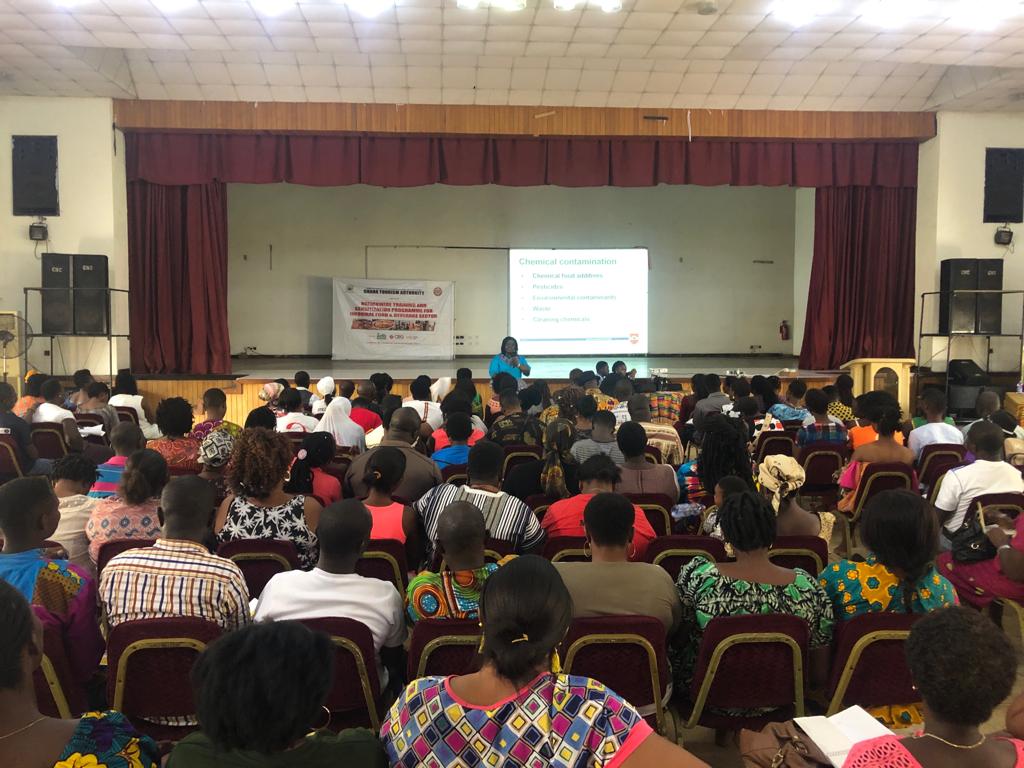
Present at the training programme held at the Centre for National Culture (CNC), Cape Coast in the Central Region were Executives of the Ghana Tourism Federation (GHATOF) in the region, officials of the Ghana Tourism Authority (GTA) and Tourism Development Fund (TDF). Officials include Mr. Ekow Sampson, Deputy Chief Executive (Operations), Mr. Prince Essah, Tourism Development Fund Manager, Mr. Alex Boakye (Manager, Standards and Quality Assurance, GTA Head Office, Accra), Mr. Kwame Gyasi (Regional Manager, Central Region, GTA), Dr. Mrs. Patricia Owusu-Darko, Training Facilitator and Dean of the Graduate School of the Kumasi Technical University (KTU), Mr. Maxwell Amo Ghunney – Regional Chairman and National Organiser of NADBOA, Mr. J. R. Quainoo – Regional Chairman of Ghana Bar Operators Association (GHABOA), Albert Aidoo-President and Executive of Indigenous Caterers Association, Isaac Kojo Biney – Cape Coast Branch of NADBOA.
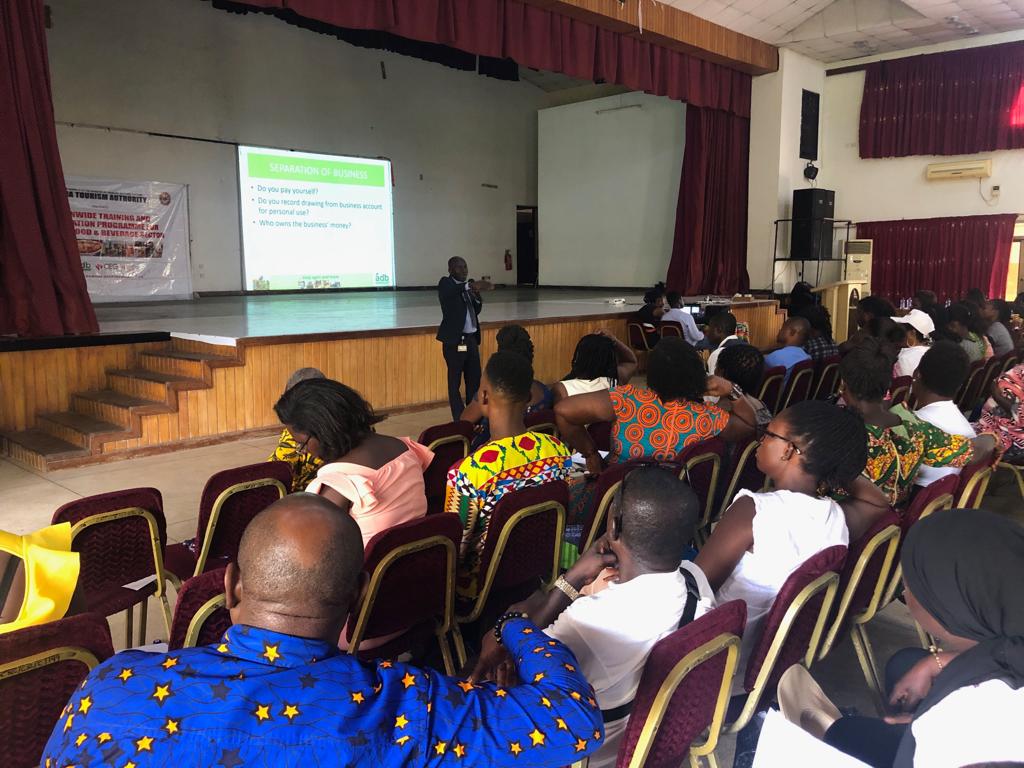
Present at the training programme held at Melody Hotel, Takoradi, Western Region were Executives of the Ghana Tourism Federation (GHATOF) in the region, officials of the Ghana Tourism Authority (GTA) and Tourism Development Fund (TDF). They include Mr. Ekow Sampson, Deputy Chief Executive (Operations), GTA, Mr. Alex Boakye (Manager, Standards and Quality Assurance, GTA Head Office, Accra), Mr. George Ansere (Regional Manager, Western Region, GTA), Dr. Mrs. Patricia Owusu-Darko, Training Facilitator and Dean of the Graduate School of the Kumasi Technical University (KTU), Rosemond Essuman (Financial Secretary of Traditional Caterers Association Western Region, Nana Oteng (Chairman) and Gladys Otoo (Vice Chairperson) of National Drinking Bar Operators Association (NADBOA).
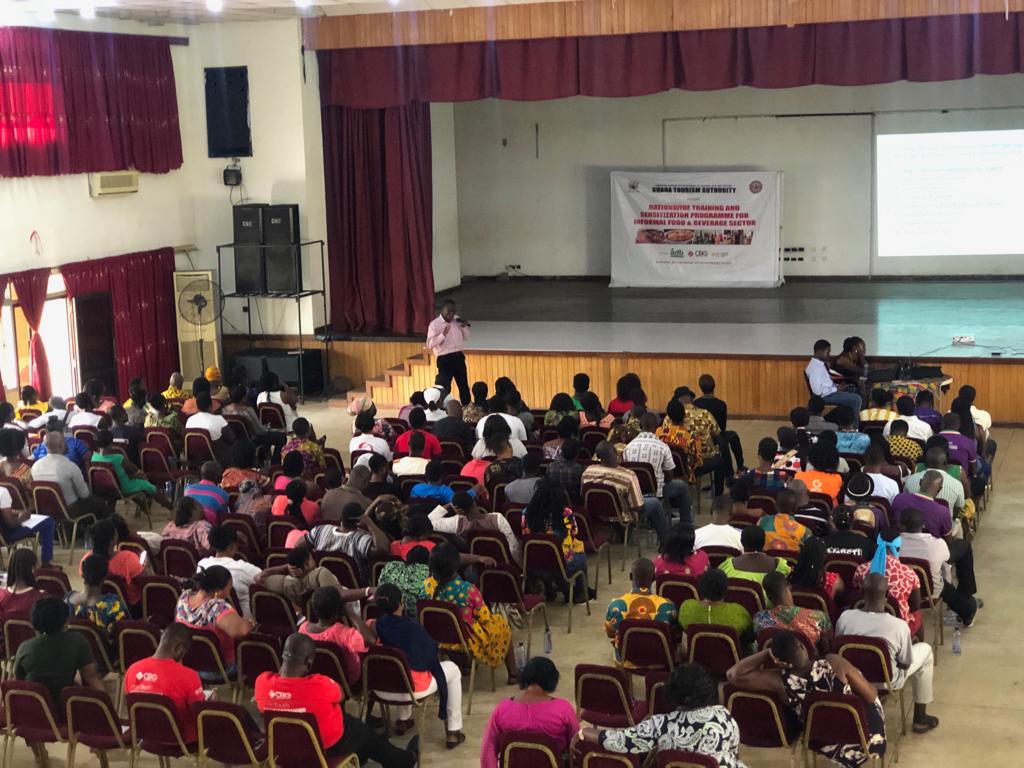
The training programme commenced in the Greater Accra, Tema and Eastern Regions of Ghana. This offered the operators to learn and share ideas on how to keep their food and drinks in a safe hygienic condition. Moreover, it gave Operators the opportunity to learn about the Legislative Instruments that regulates the food and beverage sector as well as basic bookkeeping principles.
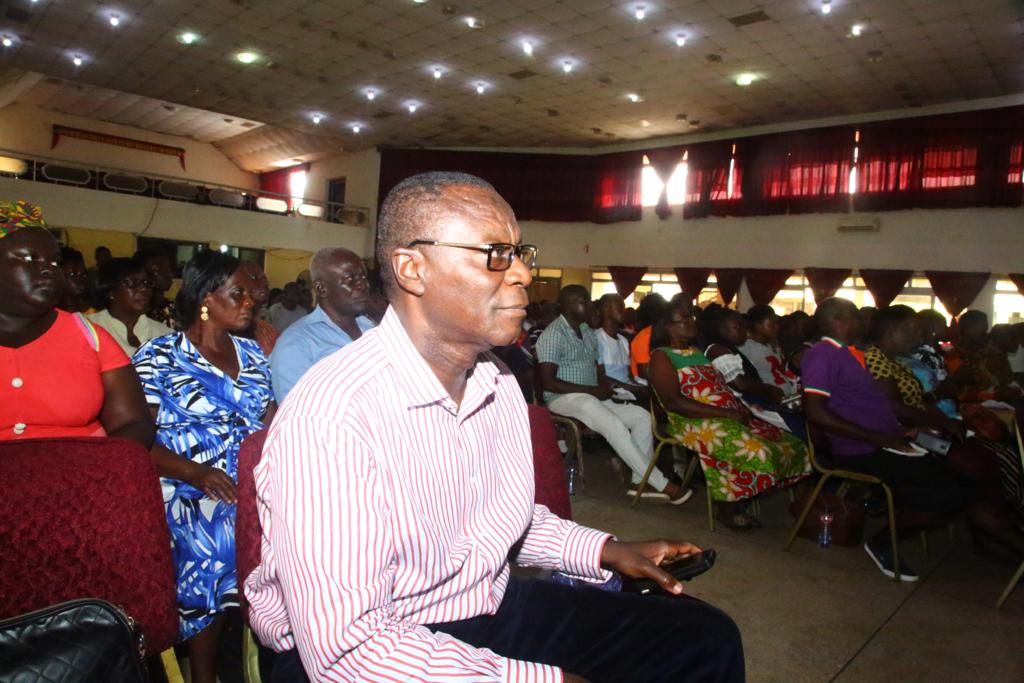
The Informal sector is a key component of the Tourism Industry since they are the first point of call to tourists and the Global African Family (People of African descent) as we commemorate the slave trade movement and celebrate African resilience in “THE YEAR OF RETURN, GHANA 2019”. The Informal Sector constitutes about 80% of the Tourism Industry and therefore, there was the need to train operators on issues that will help boost their businesses and encourage them to contribute substantially to the Tourism Development Fund (TDF).
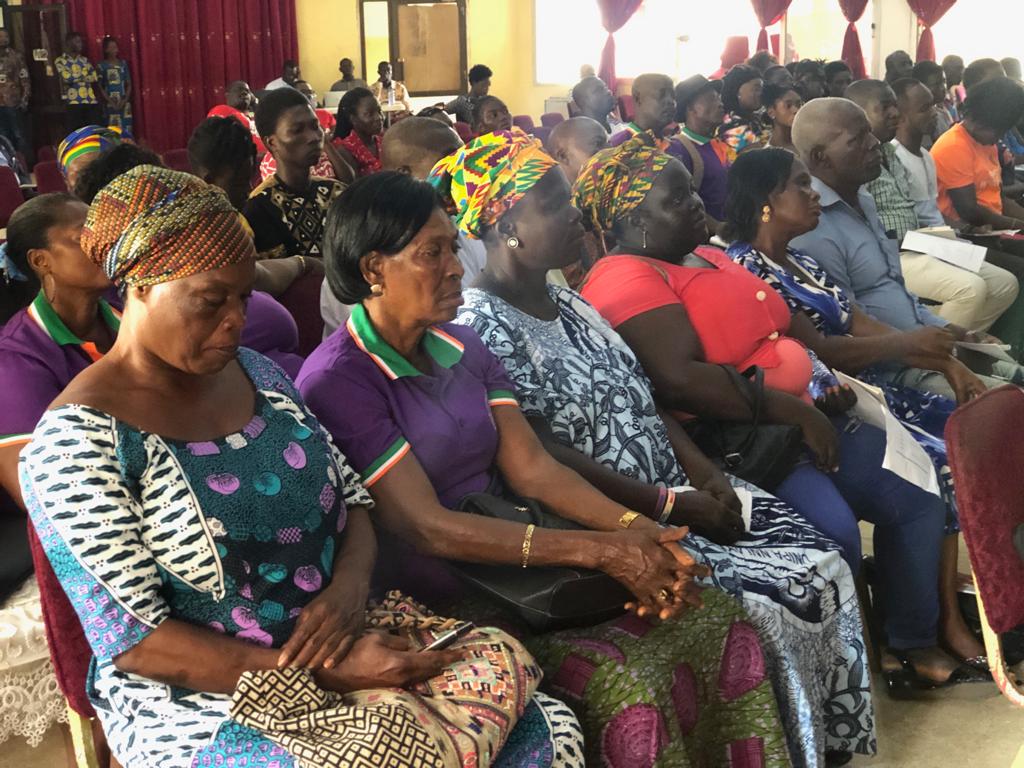
Research shows that unhygienic food contributes about 59.8% to food-borne diseases such as cholera and about 16.9% also comes from food poisoning. Moreover, the issue of quality service delivery is very paramount to the operations of the Ghana Tourism Authority. It is therefore imperative that food and beverage vendors were trained to apply best and healthy practices as they serve the consuming public, tourists as well as Africans in the diaspora who have arrived for the “YEAR OF RETURN, GHANA 2019”.
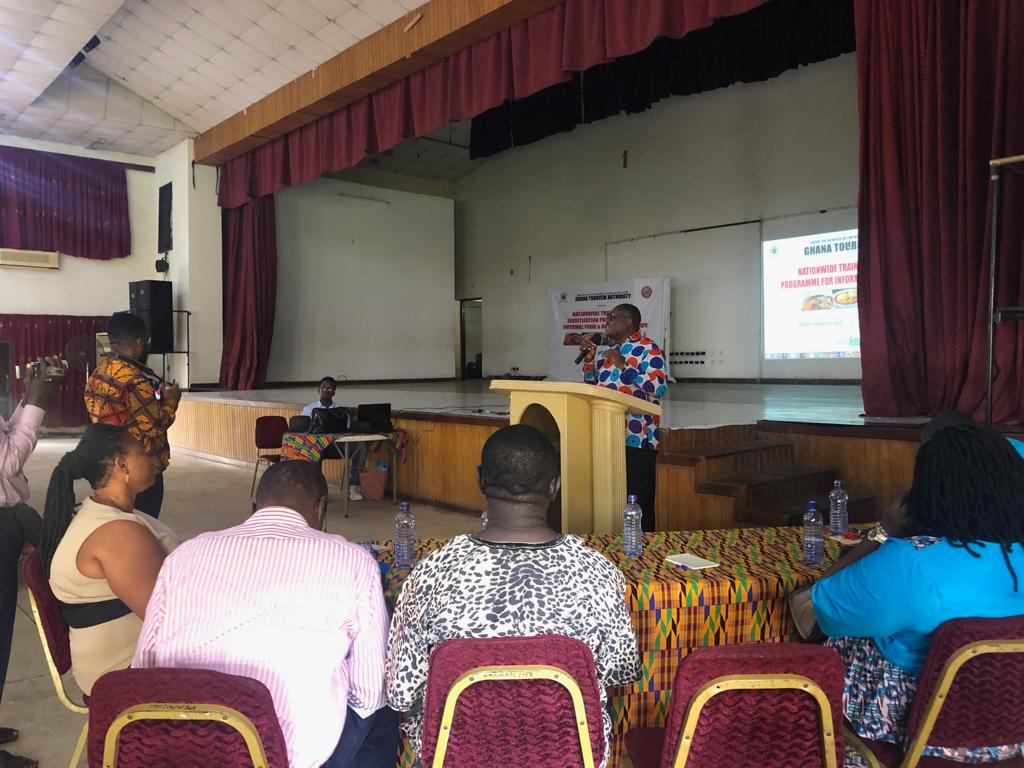
The Operators on their part expressed appreciation to the Ghana Tourism Authority (GTA) and the Tourism Development Fund (TDF) for the training and indicated that they will impact same knowledge acquired to their fellow workers and colleagues in order to enhance the quality of service delivered to boost the tourism industry.
The Training programme covered the following areas :
• Food safety and Hygiene
• Food and Beverage Services
• Legislative Instruments (LI) 2238 and 2185
• Finance and Accounting Basics (Book Keeping)
A large number of Operators have been trained so far across the country comprising Greater Accra, Tema, Eastern, Central and Western Regions of Ghana.
The Training programme will continue in the Ashanti, Brong Ahafo, Northern, Volta, Upper East and Upper West Regions as follows:
i. ASHANTI – MONDAY, 9TH SEPTEMBER, 2019
ii. BRONG AHAFO – WEDNESDAY, 11TH SEPTEMBER, 2019
iii. NORTHERN – FRIDAY, 13TH SEPTEMBER, 2019
iv. UPPER EAST – MONDAY, 16TH SEPTEMBER, 2019
v. UPPER WEST – WEDNESDAY, 18TH SEPTEMBER, 2019
vi. VOLTA – TUESDAY, 24TH SEPTEMBER, 2019
“WAGHANDA FOREVER!” IN THIS YEAR OF “RETURN,” MEMBERS OF THE “LOST TRIBE” CELEBRATE GHANA AND AFRICA’S POSSIBILITIES
Naia, Netta, and Mitty, at the Door of No Return. My daughter said: “Dad, I didn’t quite expect to see so many Mercedes on the road.” “Or cell phones everywhere,” added my girlfriend, “even with the street vendors.” I smiled, and turned from the guidebook to join them gazing out the bus window. True, their first trip to the Motherland was exposing them to a Ghana with more modern trappings than I observed in my prior journey 20 years ago when the country was just beginning its major economic ascent, becoming in 2011 not just Africa’s but the world’s fastest-growing economy. Yet the bus still had to crawl frequently over gnarly road conditions, giving us a clear view of the shacks and barefoot children that filled the landscape on our five hour journey from Accra north to Kumasi. “Dad,” my curious one chimed in again, “it seems like there are two Ghanas.” Let me back up to explain briefly that our 10-day journey was inspired by Ghana’s declaration of the “Year of Return” – the 400th commemoration of the Trans-Atlantic slave trade. It peaked the interest of my 15 year-old Naia and my girlfriend Antoinette (“Netta”); and it stirred in me the desire to reconnect with this country for which I had experienced love at first sight those many years ago. And so we heeded the call, for when Ghanaians – renowned for their warm smiles and sincere spirits – say “Akwaaba” (welcome), who can resist? Perhaps it is this open spirit that also explains the unification of this rapidly growing country, which is smaller than the state of Oregon and has nearly quadrupled in population over the last 50 years to its current 30 million. Ghana stands out not only because of its English-speaking capacity and political stability but its peaceful coexistence of 70-plus ethnic groups and its mix of Christians, Muslims and followers of traditional religion. One of the reasons why I consistently recommend Ghana as a starting point for those visiting the Motherland is its clear sense of a distinct, vibrant identity – the cadence, rhythm and passion of Twi, Ga, Ewe, and Fante; the bold, brightly-colored patterns of the Ashanti kente cloth; people’s elegant, straight-back stride; and the captivating “High-life” music pumping from car stereos and street vendor’s radios. Ghanaians have much to be proud of: their many indigenous cultures and languages which have not perished with English or modernization; their rich Ashanti traditions and continuing lineage of local royalty; and their transition, following 20 years of military coups, to democratic rule and effective multiparty elections with 70-plus percen participation rates (versus the USA’s 55%) and a peaceful transfer of power in 2016 between rival parties. Indeed, it was Ghana’s courage and leadership as Africa’s first country to break the yoke of colonialism that spurred on the succession of 1960s independence movements. Appreciation here extends not only to visionary statesman and prolific author Kwame Nkrumah but also to the mass movements behind him – and the women. We learned how this stems from the fighting spirit of Yaa Asantewaa – the 60 year old Queen Mother who led the Ashanti into battle against the British after they exiled her grandson the king. And, the country’s openness embraced our African American intellectual giants W.E.B. and Shirley DuBois, both of whom renounced their American citizenship and moved to the capital Accra in 1961 where W.E.B. died and is buried, after helping to forge the vision of Pan Africanism to unite the Continent and liberate Black people everywhere. They were followed by many African-Americans who planted the seeds of “return,” choosing to repatriate or consider Ghana their second home, including Maya Angelou and Malcolm X. It was inspiring to see large tour groups of our sisters and brothers continuing this tradition by making this pilgrimage, and learning that some have for years been deepening their ties here, buying property and making investments. “But do they see us?”, asked Mr. Alote, a local analyst and griot-historian whom we befriended at Accra’s Jamestown Café, a new center dedicated to promoting art and intellect, owned by acclaimed architect Joe Osae-Addo and his sister Maanaa, who was our gracious host. As he walked with us through Jamestown’s bustling neighborhoods, Alote raised a skeptical eyebrow about the perspective of those who are returning – seemingly concerned only about the past, while overlooking the plight of the people living today in the shadow of the slave fortresses. Though perhaps unintended, the three of us were forced to see. Undertaking long road trips and utilizing public transportation – including waiting for hours at local markets for the bus to fill – we observed first-hand that it is an extremely hard life for most people. Ghana is widely recognized for having done much to reduce poverty, yet 25% of the population still earn less than $240 a year; begging and homelessness is growing, and housing shortages, pollution and disease are severe in certain areas, with social programs notably underfunded. Conversely, “the number of millionaires will increase by 80% over the next decade and the country’s wealthiest 80 people own the equivalent of 7% of the country’s entire GDP”- as evidenced by the high-end shops we saw at the new malls, and the proliferation of expensive cars on the road. Brother Alote’s observations were worth considering, leaving me wondering about a sometimes overly sentimentalized notion of “return” by us privileged westerners who can afford thousands of dollars for the journey with a myopic focus on the past. I felt compelled to ask “return for what?” Indeed, was that not essentially the cry and demand of the people against their own beloved Kwame Nkrumah: “Independence — for what?” Nkrumah whose statue was toppled when he was overthrown in 1966. As noted by Thomas – our young, bright and impassioned guide at the Nkrumah mausoleum – the severed bronze head remains seated separately, ominously, as a stark reminder of the challenges of power and the potential consequences if leaders do not remain accountable to their people. “We seek more than a change in composition of our oppressors; we seek freedom,” Thomas said proudly. For this reason, the slave castles of Cape Coast and Elmina were particularly poignant for me on this trip. I cried; we cried; the groups of fellow sojourners all cried – for the dark, cramped dungeons, the torture rooms, the water pool above, specially designed to ensure that those attending chapel on top would not have to hear the cries and clang of the shackles below, the “Door of No Return” – all are harrowing reminders of man’s inhumanity to man. But they also remind us of the complicity of local kings and chiefs in the slave trade. Inspired by the Adinkra symbol “Sankofa” – learning from our past -we must never allow new forms of enslavement, whether by multi-national corporations or local businesses, not on ships this time but in sweatshops. Ghana’s great bounty – the precious minerals, oil, gas and a highly diversified economy – offer prosperity for not only a few but for the collective good, which is a common concern of many African traditions. Perhaps a new Diasporic partnership, spawned from the vision of DuBois and the Pan African pioneers, can fuel a new dialogue on building a truly justeconomy based not merely on “growth” but also on a real commitment to distribution and quality of life (health, education, living wage, etc.) for the average person; and hopefully it will address the paradox of persistent poverty within the wealthiest continent, possessing 70% of the world’s mineral resources. A new, productive conversation would move beyond the common refrain of “corruption” to address the fundamental underlying issues of extraction and the undercounting and siphoning off of the Continent’s massive wealth. After all, it was Nkrumah who warned against such insidious patterns of “neocolonialism,” patterns which may explain why all of Ghana’s riches and economic growth are somehow still rated in the “official” global indicators at a value that is one-third below the economy of Cuba, a country considerably smaller by size and population, virtually absent mineral resources and US investment, and operating outside of “free market” principles. Embarking on its own path, Ghana, could become a real-life “Wakanda” – “WaGHANdA”! – leading a Continental and Diasporic commitment to local ownership, control and processing of its own natural resources; to prioritizing local goods over its extensive imports; to cultivating new technologies that are sustainable and life-affirming; and to building a “development” model that is not constrained by “growth” and accumulation in the hands of a few but cares for distribution and quality of life for all. Gathered on our last evening for a talk by scholar Kojo Yankah at the Jamestown Café on the state of the Black Diaspora, a young Ghanaian-Londoner asked how we influence the next generation against the tide of social media and commercialism. I have faith that with its proud traditions, political stabilization, strong economy, increasing commitment to education, and cultural vitality – Ghana – with solidarity and support from the Diaspora and loving allies — will find a way. In fact, it offers the hope for new, distinct and sustained African identity that doesn’t seek to emulate the West. It is perhaps this distinct creative element that can assist the contagious transmission of a new, transcendent vision beyond materialism, consumerism and individualism — focused instead on collective liberation, the realization of full human potential, and planetary survival. In this designated “Year of Return,” a marker was placed on the back of Cape Coast castle – at the very spot where our enslaved ancestors took their final steps before being hauled into that horrific Middle Passage. Above the final portal there is now a new sign: “Door of Return.” As we turn and confront our past, let us not only draw from history but commit to forging a truly transformed future. “WaGHANdA Forever!”
source: blackstarnews.com
Ghana Tourism Authority Declares September, Month Of Tourism
The Ghana Tourism Authority (GTA) under the auspices of the Ministry of Tourism, Culture and Creative Arts, has declared September a Month of Tourism geared towards promoting domestic tourism and whipping up public interest.
This coincides with the United Nations World Tourism Organisation (UNWTO) celebration of the World Tourism Day (WTD) 2019 slated for September 27, in India, on the theme: “Tourism and Jobs: A Better Future for All.”
Ghana’s celebration, as a member of the UNWTO, is to highlight the importance of the tourism sector to the economy and to mark the ‘Year of Return’ during which the Ashanti Region would host the WTD celebrations.
Mr Ekow Sampson, the Deputy Chief Executive, GTA, who made the declaration at a media briefing, said that Government was pursuing quality tourism development, which was internationally competitive and well-suited to Ghana’s social values and environmental setting.
He said aside its economic benefits, tourism helped to market the country’s cultural, historic and environmental heritage to the international community and educate the indigenes on their country’s values.
He said the GTA had initiated a national theme dubbed: “See Ghana, Eat Ghana, Wear Ghana and Feel Ghana,” an innovative marketing strategy to enable Ghanaians to appreciate their tourism, culture and creative arts potentials and engender cross-culture exchanges as well as a culture of travel.
Mr Sampson said the Authority had endorsed a number of festivals as avenues to propagate national culture as they connected citizens to their roots, origins, values and cultural heritage.
He called on the private sector and the media to promote the Authority’s initiative and the declaration of September as the month of tourism in Ghana.
Activities earmarked include Asogli and Fetu Festivals on September 7, Wormanne African Ware Festival, September 20-23, Nkrumah Memorial Lecture series, September 21, Music Conversation Summit, September 25 to 26, and Ngmayem Festival, September 28. There would also be the ‘Yen Ko Kwahu Festival’ in partnership with Kwahu Professionals Network (KPN) and other Kwahu groups from September 20-25.
The celebrations would be held in the Greater Accra, Ashanti, Eastern, Volta and Central regions from September 1 to 29.
Mr Davis Opoku Ansah, the President of Kwahu Professionals Network in the Eastern Region, said the most of the activities would be held in the Region to showcase tourists’ destinations that most people were not aware of and urged the media to create awareness of all events to make the celebration a success.
Source: peacefmonline.com
Kojo Black commemorates Year of Return with ‘Sunshine in Africa’ song
As this year has been adjudged as the “Year of Return, Ghana 2019” an initiative set aside to commemorate this quarter-centenary since the anchoring of the first slave ship in Jamestown, Virginia, Ghanaian musician Kojo Black has released a music video which best suites this memorable occasion.
Titled “Sunshine In Africa” and features Atimbila, the distinctive music video was shot in a location believed to be in the Northern geographical area of Ghana. The clearly tells his history of Ghana and Africa at large as the apparels worn in this visuals were clearly an African cultural way of dressing.
The video which was directed Soba displays beautiful and rich vegetation inherited from the firefighters of Ghana’s independence. It also displays some of the most interesting tourist sites in Ghana. Vixens in this wonderful piece were seen holding national colours of another African country, thus, the flags of Nigeria, South Africa, Ghana, Burundi, Guinea, Liberia, Kenya, etc.
Kojo Black in the video was urging the Ghanaian and African diaspora to return back to learn more about the history of their forefathers.
The “Year of Return, Ghana 2019” is a major landmark spiritual and birth-right journey inviting the Global African family, home and abroad, to mark 400 years of the arrival of the first enslaved Africans in Jamestown, Virginia. The arrival of enslaved Africans marked a sordid and sad period when our kith and kin were forcefully taken away from Africa into years of deprivation, humiliation and torture.
While August 2019 marks 400 years since enslaved Africans arrived in the United States, “The Year of Return, Ghana 2019” celebrates the cumulative resilience of all the victims of the Trans Atlantic slave Trade who were scattered and displaced through the world in North America, South America, the Caribbean, Europe and Asia.
Watch video below
Source: ghanaweb.com
Bisa Aberwa Museum Opens To General Public In October
The Bisa Aberwa Museum created by the legendary Kwaw Paintsil Ansah, one of Africa’s most respected filmmakers and founder of TV Africa will formally be opened to the public on October 26, 2019.

Bisa Aberwa Museum houses one of the world’s largest private collections of artefacts, sculpture and audio-visual representations of the African story.

The specimens on display are about personalities whose sacrifices have helped shape African history, both within the continent and the diaspora.
They capture events within the slave dungeons in Africa, the toils of the Africans on the slave plantations and highlights of the Civil Rights Movement culminating in the election of the first African American as President of the United States of America.

The museum was earlier inaugurated by Her Excellency the First Lady of Ghana, Mrs Rebecca Akufo Addo, at an impressive ceremony on 28th July 2019.

Bisa Aberwa Museum has about 2,200 exhibits and located at Nkotum Mpo in Sekondi in the Western Region of Ghana. On display are cutting edge sculptural and audiovisual representations of Africa’s glorious past and the events and personalities who shaped that history. Museologists and other well-travelled individuals who have had an encounter with Bisa Aberwa testify to its uniqueness, one of a kind by a private individual.
DELEGATION OF AFRICAN AMERICANS TO GHANA TO COMMEMORATE YEAR OF RETURN
Nearly 300 African Americans reconnected with their African roots in the journey of a lifetime marking the 400th Anniversary of the Transatlantic Slave Trade
NAACP led a delegation of nearly 300 African Americans, ranging in age from 4 to 90, on a transformative journey from Jamestown, VA to Jamestown, Ghana to reconnect with their African roots and commemorate the Year of the Return – a landmark spiritual and birth-right journey inviting the global African family, home and abroad, to mark 400 years since the arrival of the first enslaved Africans to the United States.
“In the Twi language of Ghana, ‘Sankofa’ translates to ‘go back and get it.’ We are standing in our ‘Sankofa’ moment,” said NAACP President and CEO Derrick Johnson. “We are proud to return to Ghana to walk in the footsteps of our ancestors and reaffirm that our existence is one of strength, power, resilience and liberation. This experience has brought us all closer together and we have the knowledge we need to continue to fight for all of mankind. Strangers became sisters, fathers became mentors, children became playmates and a generation of the Black diaspora found their home.”
The journey began August 19th with a ceremony at the Jamestown Historic Center to honor the first enslaved Africans to arrive at Point Comfort and Fort Monroe near Hampton, VA. The reflective, yet uplifting event included a processional, remarks from local and national NAACP leaders and an opportunity for participants to write messages to their ancestors.
The following day, the group visited the Smithsonian National Museum of African American History & Culture in Washington, DC before traveling from Dulles International Airport to Accra, Ghana. Here are highlights from Ghana:
Akwaaba! Homecoming Celebrations
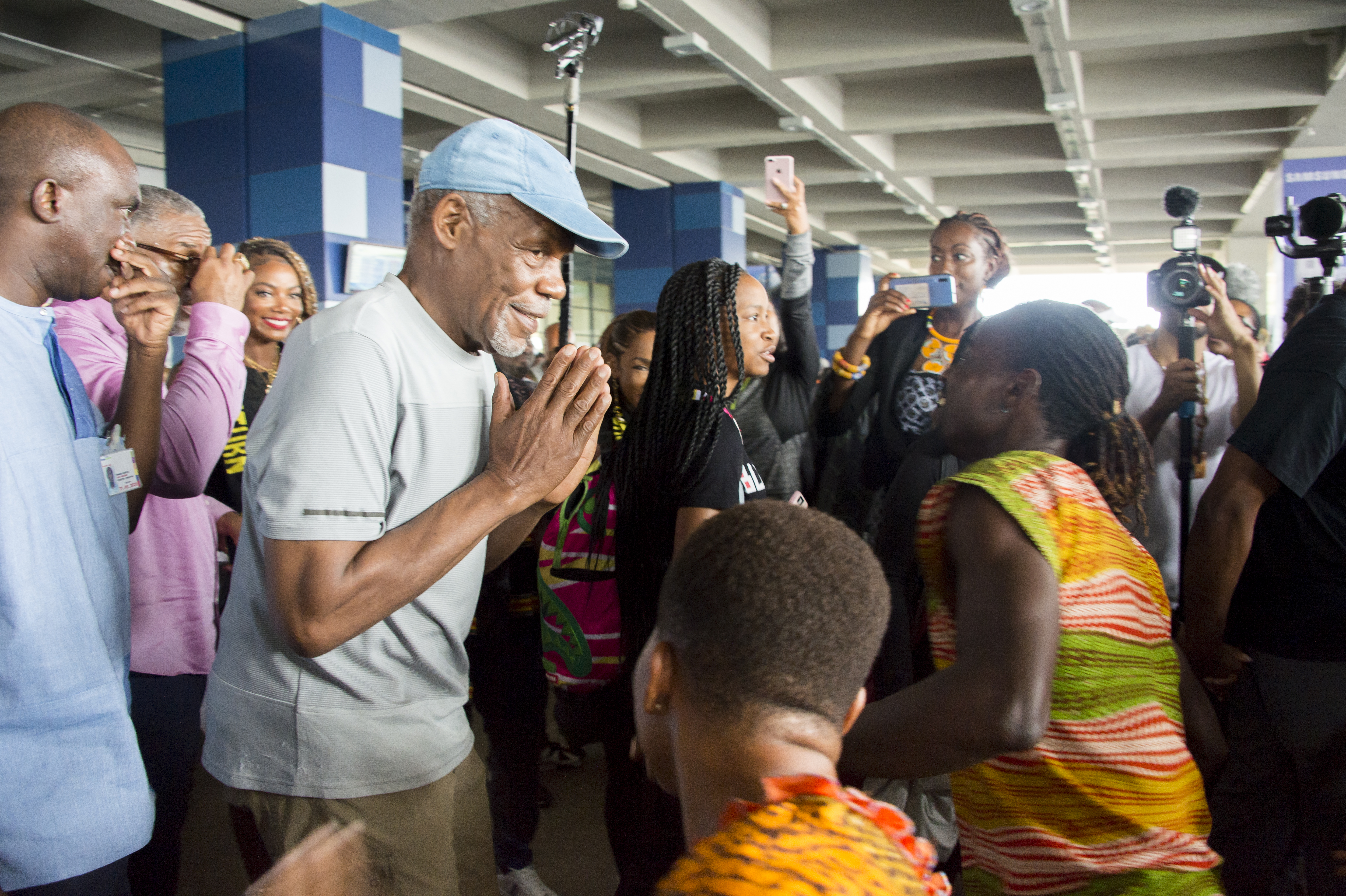
Drummers, dancers and local residents greeted the NAACP delegation at Kotoka International Airport, which included actor and humanitarian Danny Glover, as the group made their long-awaited arrival for the Year of Return. The group was first welcomed to the Jubilee House – the residence and office to the President of Ghana – for a photo opportunity, before heading to the Accra Visitor Center to meet with representatives from the Ghana Tourism Authority.
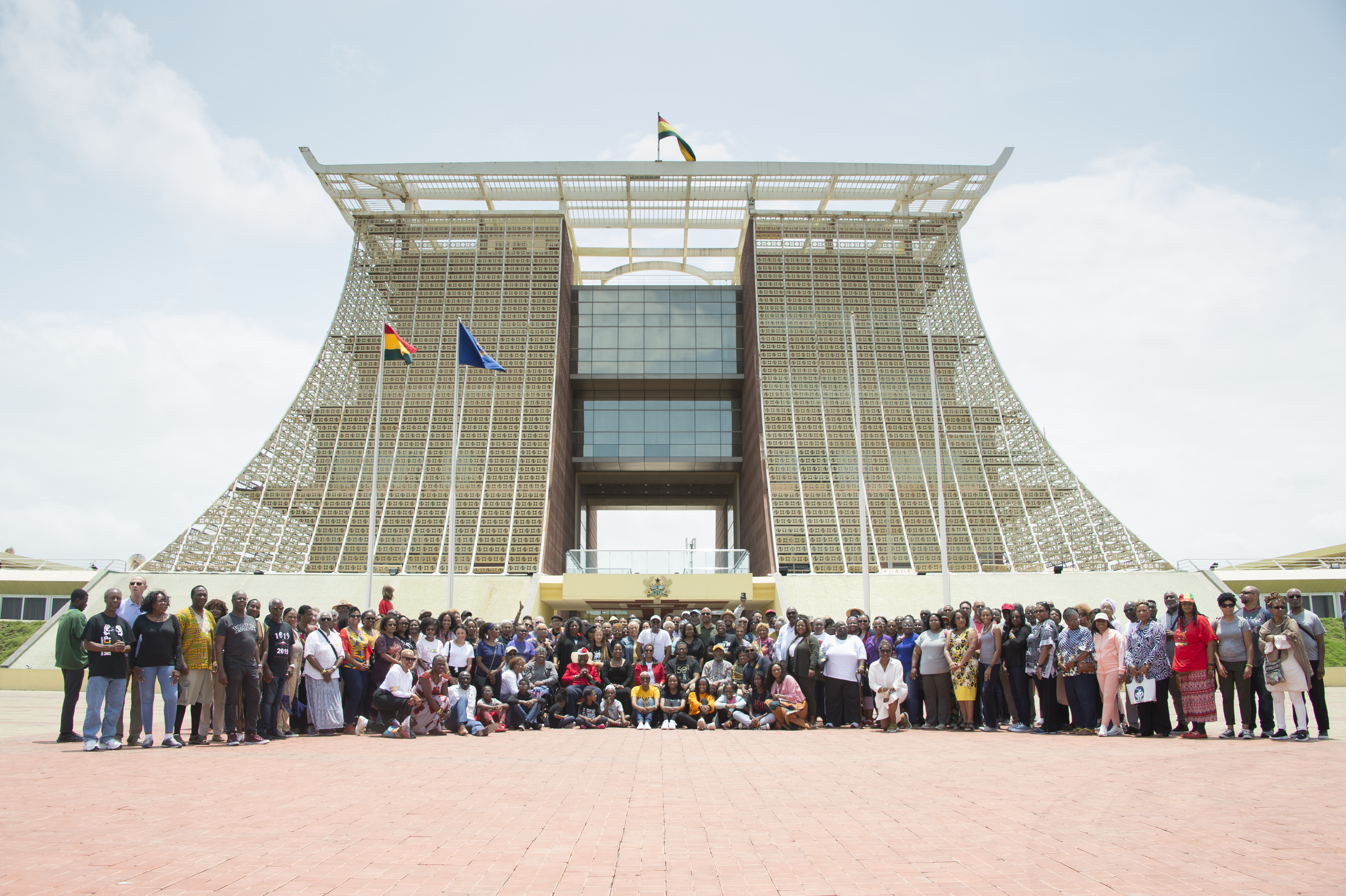
Per Ghanaian tradition, the group paid a visit to the Mayor of Accra and Jamestown chiefs, who to announce their arrival welcomed them with a blessing. Warm greeting remarks were also provided by President Nana Akufo-Addo of Ghana.
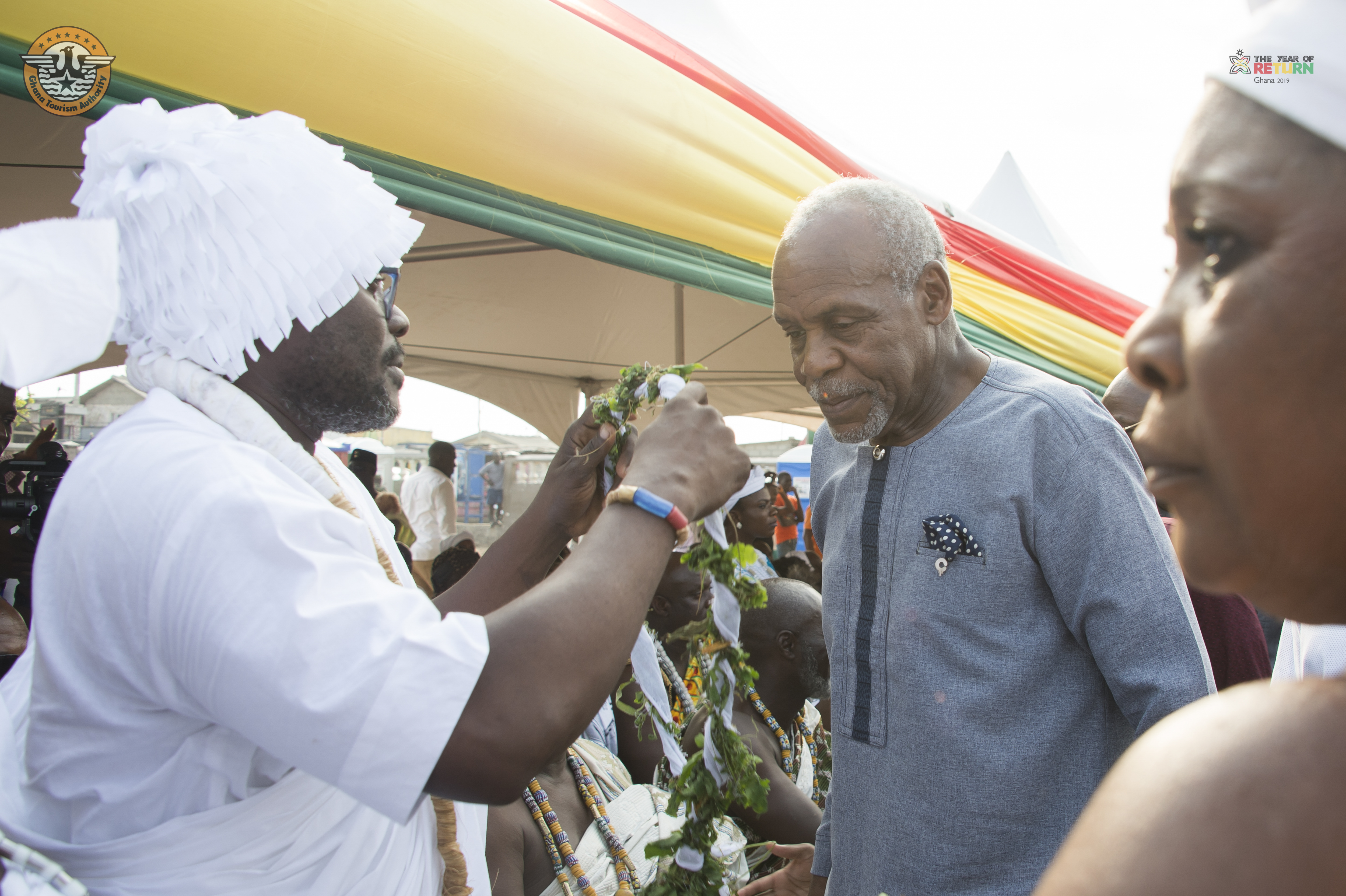
The group also paid visits to the village chiefs and elders in Cape Coast, as well as the Ashanti Queen Mother, a direct descendant of Nana Yaa Asantewaa – one of Ghana’s most acclaimed heroines.
The group visited Cape Coast Slave Castle – one of several castles along the coast of West Africa – where millions of Africans suffered in dungeons at the hands of European slave traders. As the group wandered from chamber to chamber, hanging on to every word as the guide narrated the painful history of the ground they walked on, the agony in the air was almost tangible.
“This has been the most life-changing moment of my life,” whispered an elderly woman to her daughter as they exited the female dungeons and walked toward the Door of No Return – the last port of exit before slaves were taken away from their homeland forever. On the other side of the door stood a placard that read, ‘Door of Return.’
“They called this the ‘Door of No Return,’” said one of the tour guides. “They didn’t want you to come back but look at us now. You have returned. You have survived, and you have returned to us.”
Following the tour, nearly 80 participants received the results of their African ancestry, through AfricanAncestry.com. People traced their roots to Cameroun, Togo, Gabon, Guinea Bissau, Sierra Leone, Liberia, Equatorial Guinea, Senegal and more. The Haynes family, a multigenerational family of women traveling from Howard County, MD, were the last participants to be called. The crowd erupted in cheer and tears of joy when it was announced they were matrilineal descendants of the Akan people of Ghana.
Participants in the Jamestown to Jamestown journey, explored two complementing sectors in Accra, the cultural landmarks and monuments, and the prime opportunities for investment in the city, and to a larger extent, what the country represents for the Black Diaspora. Hosted by the Ghana EXIM Bank, NAACP President Derrick Johnson gave poignant remarks as to the purpose of the Jamestown to Jamestown trip, reminding the group that the threat to exploit Black labor is still an unfortunate reality across the world, and the need to recognize the value and power of Black labor and consumerism.
The group also took part in a variety of group tours in Accra and the surrounding area, visiting sites such as the home and museum of one of the founders of the NAACP, W.E.B. Du Bois, the Kwame Nkrumah Mausoleum and Park, the Centre for Scientific Research into Plant Medicine, and the very first cocoa farm in Ghana, the Tetteh Quarshe Memorial Cocoa Farm.
Source: naacp.org
GTA to declare September Tourism Month with host of activities
In line with the ongoing celebration of the Year of Return Ghana 2019 celebrations, Ghana Tourism Authority (GTA) has put in place measures to keep the momentum built in the tourism sector.
GTA has designated September as ‘Tourism Month’ with the underlisted activities and festivals:
TOURISM EVENTS & ACTIVITIES FOR THE MONTH OF SEPTEMBER, 2019
| DATE | ACTIVITY | VENUE |
| September 1 – 8 | Asogli Te Za (Yam Festival) | Asogli – Volta |
| September 7 | Oguaa Fetu Afahye | Oguaa – Cape Coast |
| September 9- 15 | Axim Kundum | Axim |
| September 14 | Borbor Mfantse Afahye Festival | Mankessim, Central Region |
| September 16 – 20 | Odwira Festival | Akropong, Eastern Region |
| September 18 | Ohum Festival | Eastern Region |
| September 20 | Welcome Party [Kwahu Beye De] | Kwahu, Eastern Region |
| September 20 | Year of Return: Ghanaian Vibes in Garden: Final Call | Accra |
| September 20 – 23 | Year of Return: Wormanne African Ware Festival | Korle Gonno, Accra |
| September 21 | Year of Return: The Taste of Africa | Accra |
| September 21 | Courtesy Call On Kwahu Omanhene@Abene | Kwahu, Eastern Region |
| September 21 | Nkrumah Memorial Lectures | Du Bois Centre, Accra |
| September 21 | Tours | Kwahu, Eastern Region |
| September 21 | Taste Of Kwahu | Rock Gardens & Pool Side, Kwahu |
| September 21 | Club Night | Kwahu, Eastern Region |
| September 21-22 | Year of Return: H.E.R. Collective RED, BLACK & GOLD | ACCRA |
| September 22 | Football Match | Kwahu, Eastern Region |
| September 22 | Night Entertainment | Rock City Kwahu, Eastern Region |
| September 23 | King Of The Mountain Cycling Competition | Kwahu, Eastern Region |
| September 25 | Music Conversation Summit | Accra International Conference Centre |
| September 25 | World Tourism Day Quiz Competition | CNC – Kumasi, Ashanti Region |
| September 25 | Float | Kumasi, Ashanti Region |
| September 25 | World Tourism Day Clean Up Exercise | Kumasi, Ashanti Region |
| September 26 | Music Conversation Summit | Accra International Conference Centre |
| September 26 | World Tourism Day Tours | Kumasi, Ashanti Region |
| September 26 | World Tourism Day Symposium & Debate | CNC – Kumasi, Ashanti Region |
| September 27 | Fun&Fly Paragliding Festival Opens | Kwahu- Atibie, Eastern Region |
| September 27 | World Tourism Day Exhibition | CNC – Kumasi, Ashanti Region |
| September 27 | World Tourism Day Durbar | CNC – Kumasi, Ashanti Region |
| September 28 | Fun & Fly Paragliding Festival Continues | Kwahu- Atibie, Eastern Region |
| September 28 | Tour (with Media General – TV3 etc) | Dodi Island |
| September28 | Ngmayem Festival | Dodowa, Greater Accra Region |
| September28 | Adegbon Festival | Osuwem (Osudoku Traditional Area) Greater Accra Region |
| September 29 | Health Walk | Kwahu, Eastern Region |
| September 29 | Fun & Fly Paragliding Festival Ends | Kwahu, Eastern Region |
| September 29 | Kwabre Anwenie Festival | Mampongteng- Ashanti Region |
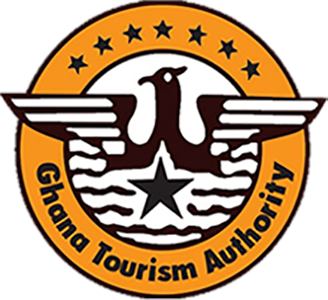

 Call Center
Call Center
